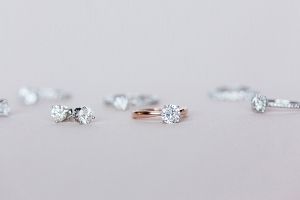
For soon-to-be engaged couples, the process of looking for a diamond ring can easily become overwhelming. Not only must one navigate the complex world of cuts and carats, there’s also the high price tag that inevitably comes with this kind of life-changing purchase. In recent years, conscientious (and cash strapped) millennials have started to skip getting a traditional diamond engagement ring altogether, as they become more aware of the the social, environmental, and financial implications of putting a ring on it.
But recently, a new option has come to the forefront and is gaining steam: lab grown diamonds. Like exactly what their name entails, lab grown diamonds are precious stones grown inside a facility, which are chemically and visually identical to natural mined diamonds. In the past five years, grown diamonds have gone from a niche industry term to a seriously alluring option for couples who are looking for that perfect diamond ring without any of the tricky conflict implications.
Noted environmentalist Leonardo DiCaprio is a large investor in a lab grown diamond company. Jewelers like Jennifer Fisher and Irene Neuwirth have started incorporating lab diamonds into their collections. And aside from their obvious ethical appeal, there’s another reason why lab grown diamonds have grown so quickly in popularity: They cost a fraction of the price of traditional mined diamonds. Conflict-free and wallet friendly? It’s no wonder that a recent study found that 70 percent of millennials would consider buying a lab-grown diamond engagement ring.
To find out more, we contacted Alexander Weindling, CEO and founder of Clean Origin, an online brand specializing in lab grown diamonds, for his take on what could become a major industry disruptor.

What is the biggest difference between a lab grown diamond and a mined one?
When it comes to the actual diamond, the only difference is the origin of where it was made—in the ground vs in a lab.
In terms of products, man-made diamonds can be anywhere from 20-30% less expensive. This can help our customers in three key ways. To start, this could mean that an individual who initially did not think they could afford a diamond, can actually surprise their soon-to-be with a gorgeous, real stone. Next, the couple that has the budget, but hates a high price tag, can save a pretty penny on this purchase and even put that saved cash towards their wedding, honeymoon, etc. And, finally, the couple that planned a budget and fully intend to spend every cent, can buy a diamond that’s 20-30% larger than one they would get from a mined jeweler.
They’re also much better for the environment, which is a huge reason why millennials make up a large chunk of our buyers. This generation sees the value in the green revolution and they’re helping out in every purchase that they can. Sometimes it can seem like a drastic action has to take place to help make strides towards an eco-friendly lifestyle. With products such as lab-created diamonds, it’s extremely simple to help make a change without a huge, daunting life change.
Is there any way to visually tell the difference between lab grown and mined diamonds?
The only way to tell the difference is due to a microscopic inscription on the bottom of lab-created diamonds that identify it as such. Without this marking, there would be no way to tell as these stones are chemically, physically, and optically the same as mined diamonds.
Just like mined stones, lab-grown diamonds also range in their color, cut, and clarity. Many times people mistake lab-grown with a 100% flawless stone, but that’s not the case. Since the growing process is simply a replicated version of what happens deep beneath our earth (carbon + high heat + high pressure), varying levels of inclusions and flaws are inevitable.
What is the price range for a lab grown diamond?
Just liked mined diamonds, the price of lab-grown stones will vary greatly depending on the four Cs—cut, color, clarity and carat. Clean Origin‘s stones start at $228 and go up to over $30,000.
Why are these diamonds considered better for the environment?
In layman’s terms, they’re not destroying our earth or oceans to drudge them up.
1 carat of mined diamond means nearly 100 square feet of disturbed land and almost 6000 pounds of mineral waste. Meanwhile, 1 carat of lab-grown diamonds disrupts just 0.07 square feet of land and only 1 pound of mineral waste.
Energy wise, mined diamonds use 538.5 million joules per carat, while grown ones use 250 million. And, much of the energy used in creating lab-grown diamonds is renewable.
How long does it take to make a lab grown diamond?
The growing process takes about 4-6 weeks. From there, the stone is then graded in the same labs where mined diamonds are graded. Each Clean Origin diamond is certified by the International Gemological Institute and every purchases comes with the relevant grading certificate.
What are some of the more popular styles on Clean Origin? What are couples gravitating towards to these days?
Our Petite Floating Gem Ring with a round center stone and our Petite Delicate Halo with a round center stone are two of our top-selling items. Round cut stones are definitely the most popular. Solitaires and classic styles are great because they’re so timeless, but halos can actually make your diamond look much larger, so those are a best-seller. We also have a new collection of diamonds called the Hearts & Arrows collection that features perfectly symmetrical lab-grown diamonds with a sparkle you have to see to believe.
This post is sponsored by Clean Origin. All opinions expressed are those of the author.












